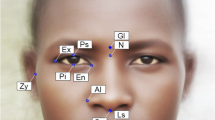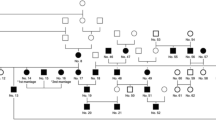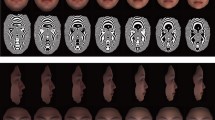Abstract
One of the most fundamental issues in forensic anthropology is the determination of sex and population affinity based on various skeletal elements. Therefore, we compared the sexual dimorphism of the upper facial skeleton from a recent Czech population (twenty-first century) with that of a population from Early Modern Age Bohemia (sixteenth to eighteenth centuries). Methods of geometric morphometrics were applied. According to the results, sexual dimorphism in terms of size, shape, and form was statistically significant in both populations. The best results of sex estimation originated from analyses of form. Thus, both size and shape differences should be taken into account for determination of the sex. The accuracy of prediction achieved 91.1% for individuals in the recent population and 87.5% for individuals from the early modern population. Only minor differences were found between sexual dimorphism in the studied populations. We conclude that sexual dimorphism of the upper facial skeleton is stable during the relatively short time period.



Similar content being viewed by others
References
Ubelaker DH, Volk CG (2002) A test of the Phenice method for the estimation of sex. J Forensic Sci 47:19–24
Phenice TW (1969) Newly developed visual method of sexing the os pubis. Am J Phys Anthropol 30:297–302
Bruzek J (2002) A method for visual determination of sex, using the human hip bone. Am J Phys Anthropol 117:157–168
Spradley MK, Jantz RL (2011) Sex estimation in forensic anthropology: skull versus postcranial elements. J Forensic Sci 56:289–296
Waldron T (1987) The relative survival of the human skeleton: implication for palaeopathology. In: Boddington A, Garland AN, Janaway RC (eds) Death, decay, and reconstruction: approaches to archaeology and forensic science. Manchester University Press, Manchester, pp 55–64
MacLaughlin SM, Bruce MF (1990) The accuracy of sex identification in European skeletal remains using the phenice characters. J Forensic Sci 35:1384–1392
Sutherland LD, Suchey JM (1991) Use of the ventral arc in pubic sex determination. J Forensic Sci 36:501–511
Byers SN (2015) Introduction to forensic anthropology, Fourth edn. Routledge, New York
Pickering RB, Bachman D (2009) The use of forensic anthropology, Second edn. CRC Press, Boca Ranton
Novotný V, İşcan MY, Loth SR (1993) Morphologic and osteometric assessment of age, sex and race from the skull. In: İşcan MY, Helmer RP (eds) Forensic analysis of the skull. Wiley-Liss, New York, pp 71–88
Konigsberg LW, Hens SM (1998) Am J Phys Anthropol 107:97–112
Graw M, Wahl J, Ahlbrecht M (2005) Course of the meatus acusticus internus as criterion for sex differentiation. Forensic Sci Int 147:113–117
Graw M, Czarnetzki A, Haffner H-T (1999) The form of the supraorbital margin as a criterion in identification of sex from the skull: investigations based on modern human skulls. Am J Phys Anthropol 108:91–96
Rogers TL (2005) Determining the sex of human remains through cranial morphology. J Forensic Sci 50:493–500
Buikstra JE, Ubelaker DH (1994) Standards for data collection from human skeletal remains: proceedings of a seminar at the field museum of natural history, organized by Jonathan Haas. Arkansas Archeological Survey, Fayetteville
Williams BA, Rogers TL (2006) Evaluating the accuracy and precision of cranial morphological traits for sex determination. J Forensic Sci 51:729–735
Giles E, Elliot O (1963) Sex determination by discriminant function analysis of crania. Am J Phys Anthropol 21:53–68
Franklin D, O’Higgins P, Oxnard CE, Dadour I (2006) Determination of sex in South African blacks by discriminant function analysis of mandibular linear dimensions: a preliminary investigation using the Zulu local population. Forensic Sci Med Pathol 2:263–268
Gonzalez PN, Bernal V, Perez SI (2011) Analysis of sexual dimorphism of craniofacial traits using geometric morphometric techniques. Int J Osteoarchaeol 21:82–91
Kimmerle EH, Ross A, Slice D (2008) Sexual dimorphism in America: geometric morphometric analysis of the craniofacial region. J Forensic Sci 53:54–57
Kranioti EF, Michalodimitrakis M (2009) Sexual dimorphism of the humerus in contemporary Cretan: a population-specific study and a review of the literature. J Forensic Sci 54:996–1000
Bookstein FL (1997) Morphometric tools for landmark data: geometry and biology. Cambridge University Press, Cambridge
Zelditch ML, Swiderski DL, Sheets HD (2004) Geometric morphometrics for biologists: a primer. Elsevier Academic Press, San Diego
Slice DE (2005) Modern morphometrics in physical anthropology. Springer Science & Business Media, New York
Mitteroecker P, Gunz P, Windhager S, Schaefer K (2013) A brief review of shape, form, and allometry in geometric morphometrics, with applications to human facial morphology. Hystrix 24:59–66
Cunha E, Van Vark G (1991) The construction of sex discriminant functions from a large collection of skulls of known sex. Int J Anthropol 6:53–66
Kemkes A, Göbel T (2006) Metric assessment of the “mastoid triangle” for sex determination: a validation study. J Forensic Sci 51:985–989
Buretić-Tomljanović A, Ostojić S, Kapović M (2006) Secular change of craniofacial measures in Croatian younger adults. Am J Hum Biol 18:668–675
Walker PL (2008) Sexing skulls using discriminant function analysis of visually assessed traits. Am J Phys Anthropol 136:39–50
Garvin HM, Sholts SB, Mosca LA (2014) Sexual dimorphism in human cranial trait scores: effects of population, age, and body size. Am J Phys Anthropol 154:259–269
Garvin HM, Ruff CB (2012) Sexual dimorphism in skeletal browridge and chin morphologies determined using a new quantitative method. Am J Phys Anthropol 147:661–670
Lewis CJ, Garvin HM (2016) Reliability of the Walker cranial nonmetric method and implications for sex estimation. J Forensic Sci 61:743–751
Ogawa Y, Imaizumi K, Miyasaka S, Yoshino M (2013) Discriminant functions for sex estimation of modern Japanese skulls. J Forensic Legal Med 20:234–238
Gapert R, Black S, Last J (2009) Sex determination from the foramen magnum: discriminant function analysis in an eighteenth and nineteenth century British sample. Int J Legal Med 123:25–33
de Paiva LAS, Segre M (2003) Sexing the human skull through the mastoid process. Rev Hosp Clin 58:15–20
Proença HHFA, Slavicek R, Cunha E, Sato S (2014) A 3D computerized tomography study of changes in craniofacial morphology of Portuguese skulls from the eighteenth century to the present. J Stomat Occ Med 7:33–45
Jantz RL, Jantz LM (2000) Secular change in craniofacial morphology. Am J Hum Biol 12:327–338
Jonke E, Prossinger H, Bookstein FL, Schaefer K, Bernhard M, Freudenthaler JW (2007) Secular trends in the facial skull from the 19th century to the present, analyzed with geometric morphometrics. Am J Orthod Dentofac Orthop 132:63–70
Godde K (2015) Secular trends in cranial morphological traits: a socioeconomic perspective of change and sexual dimorphism in North Americans 1849–1960. Ann Hum Biol 42:255–261
Franklin D, Cardini A, Flavel A, Kuliukas A (2012) The application of traditional and geometric morphometric analyses for forensic quantification of sexual dimorphism: preliminary investigations in a western Australian population. Int J Legal Med 126:549–558
Verhoff MA, Ramsthaler F, Krähahn J, Deml U, Gille RJ, Grabherr S, Thali MJ, Kreutz K (2008) Digital forensic osteology—possibilities in cooperation with the Virtopsy® project. Forensic Sci Int 174:152–156
Stull KE, Tise ML, Ali Z, Fowler DR (2014) Accuracy and reliability of measurements obtained from computed tomography 3D volume rendered images. Forensic Sci Int 238:133–140
Dedouit F, Telmon N, Costagliola R, Otal P, Florence LL, Joffre F, Rougé D (2007) New identification possibilities with postmortem multislice computed tomography. Int J Legal Med 121:507–510
Bigoni L, Velemínská J, Brůžek J (2010) Three-dimensional geometric morphometric analysis of cranio-facial sexual dimorphism in a central European sample of known sex. Homo 61:16–32
Kovarovic K, Aiello LC, Cardini A, Lockwood CA (2011) Discriminant function analyses in archaeology: are classification rates too good to be true? J Archaeol Sci 38:3006–3018
Weisensee KE, Jantz RL (2011) Secular changes in craniofacial morphology of the Portuguese using geometric morphometrics. Am J Phys Anthropol 145:548–559
Hayashi K, Saitoh S, Mizoguchi I (2012) Morphological analysis of the skeletal remains of Japanese females from the Ikenohata-Shichikencho site. Eur J Orthod 34:575–581
Wescott DJ, Jantz RL (2005) Assessing craniofacial secular change in American blacks and whites using geometric morphometry. In: Slice DE (ed) Modern morphometrics in physical anthropology. Kluwer Academic Publishers-Plenum Publishers, New York, pp 231–245
Jantz LM (2004) The meaning and consequences of morphological variation. In: The American Anthropological Association (AAA) (2003) Annual meeting on November 21, 2003. Illinois, Chicago, pp 1–17
Saini V, Srivastava R, Shamal SN, Singh TB, Pandey AK, Tripathi SK (2011) Sex determination using mandibular ramus flexure: a preliminary study on Indian population. J Forensic Legal Med 18:208–212
Galdames ICS, Matamala DAZ, Smith RL (2008) Evaluating accuracy and precision in morphologic traits for sexual dimorphism in malnutrition human skull: a comparative study. Int J Morphol 4:877–881
Oettlé AC, Pretorius E, Steyn M (2009) Geometric morphometric analysis of the use of mandibular gonial eversion in sex determination. Homo 60:29–43
Stinson S (2005) Sex differences in environmental sensitivity during growth and development. Am J Phys Anthropol 28:123–147
Kozák P (2009) Dějiny tzv. Nového hřbitova. Příspěvek k raně novověké topografii města Opavy. In: Kouřilová D (ed) Sborník Národního památkového ústavu v Ostravě 2009. Opavsko: památky - historie - osobnosti. Národní památkový ústav, Ostrava, pp 93–111
Kováčik P, Zezula M (2009) Opava–Pivovar (horní dvůr). Zjišťovací archeologický výzkum v místě stavebního záměru OSC Breda a Weinstein (akce 73/08). Archive of National Heritage Institute (NPÚ–ÚOP)
Zezula M, Kozák P, Pankowská A, Plaštiaková M (2010) Opava. Areál pivovaru (tzv. horní dvůr), p. č. 128/7, 128/8. Zjišťovací výzkum. Archive of National Heritage Institute (NPÚ–ÚOP)
von Cramon-Taubadel N, Frazier BC, Lahr MM (2007) The problem of assessing landmark error in geometric morphometrics: theory, methods, and modifications. Am J Phys Anthropol 134:24–35
Rohlf FJ, Slice D (1990) Extensions of the Procrustes method for the optimal superimposition of landmarks. Syst Biol 39:40–59
Klingenberg CP (2002) Developmental instability as a research tool: using patterns of fluctuating asymmetry to infer the developmental origins of morphological integration. In: Polak M (ed) Developmental instability: causes and consequences. Oxford University Press, New York, pp 427–442
Drake AG, Klingenberg CP (2008) The pace of morphological change: historical transformation of skull shape in St. Bernard dogs. Proc R Soc B 275:71–76
Klingenberg CP (1996) Multivariate allometry. In: Marcus LF, Corti M, Loy A, Naylor GJP, Slice DE (eds) Advances in morphometrics. Springer, New York, pp 23–50
Cortes C, Vapnik V (1995) Support-vector networks. Mach Learn 20:273–297
Navega D, Coelho C, Vicente R, Ferreira MT, Wasterlain S, Cunha E (2014) AncesTrees: ancestry estimation with randomized decision trees. Int J Legal Med 129:1145–1153
Van Vark GN, Schaafsma W (1992) Advances in the quantitative analysis of skeletal morphology. In: Sanders M, Katzhenberg M (eds) Skeletal biology of past peoples: research methods. Wiley-Liss, New York, pp 225–257
Green H, Curnoe D (2009) Sexual dimorphism in southeast Asian crania: a geometric morphometric approach. Homo 60:517–534
Ferembach D, Schwidetzky I, Stloukal M (1980) Recommendations for age and sex diagnoses of skeletons. J Hum Evol 9:517–549
İşcan MY, Steyn M (2013) The human skeleton in forensic medicine, Third edn. Charles C Thomas Publisher, Springfield, Illinois
Steyn M, İşcan MY (1998) Sexual dimorphism in the crania and mandibles of South African whites. Forensic Sci Int 98:9–16
Veyre-Goulet SA, Mercier C, Robin O, Guérin C (2008) Recent human sexual dimorphism study using cephalometric plots on lateral teleradiography and discriminant function analysis. J Forensic Sci 53:786–789
Bejdová Š, Krajíček V, Velemínská J, Horák M, Velemínský P (2013) Changes in the sexual dimorphism of the human mandible during the last 1200 years in central Europe. HOMO-Journal of Comparative Human Biology 64:437–453
Lestrel PE, Kanazawa E, Wolfe CA (2011) Sexual dimorphism using elliptical Fourier analysis: shape differences in the craniofacial complex. Anthropol Sci 119:213–229
Tosi LL, Boyan BD, Boskey AL (2005) Does sex matter in musculoskeletal health? J Bone Joint Surg Am 87:1631–1647
St Hoyme L, İşcan MY (1989) Determination of sex and race: accuracy and assumptions. In: İşcan MY, Kennedy KAR (eds) Reconstruction of life from the skeleton. A.R. Liss, New York, pp 53–94
Ulijaszek SJ, Mann N, Elton S (2012) Evolving human nutrition: implication for public health. Cambridge University Press, New York
Brázdil R, Pfister C, Wanner H, Storch HV, Luterbacher J (2005) Historical climatology in Europe—the state of the art. Clim Chang 70:363–430
Svoboda J, Vašků Z, Cílek V (2003) Velká kniha o klimatu zemí Koruny české. Czech Republic, Regia
Dofkova M, Kopriva V, Resova D, Rehurkova I, Ruprich J (2001) The development of food consumption in the Czech Republic after 1989. Public Health Nutr 4:999–1003
Appleby AB (1980) Epidemics and famine in the little ice age. J Interdiscip Hist 10:643–663
Beranová M (2005) Jídlo a pití v pravěku a ve středověku. Academia, nakladatelství Akademie věd České republiky, Praha
Hetherington R, Reid RGB (2010) The climate connection: climate change and modern human evolution. Cambridge University Press, New York
Swaddle JP, Reierson GW (2002) Testosterone increases perceived dominance but not attractiveness in human males. Proc R Soc Lond B Biol Sci 269:2285–2289
Snyder JK, Kirkpatrick LA, Barrett HC (2008) The dominance dilemma: do women really prefer dominant mates? Pers Relatsh 15:425–444
Thayer ZM, Dobson SD (2010) Sexual dimorphism in chin shape: implications for adaptive hypotheses. Am J Phys Anthropol 143:417–425
Andersson MB (1994) Sexual selection. Princeton University Press, Princeton
Listi GA, Bassett HE (2006) Test of an alternative method for determining sex from the os coxae: applications for modern Americans. J Forensic Sci 51:248–252
Acknowledgements
The authors thank Archaia Olomouc o.p.s. (Peter Kováčik) for the access to the skeletal collection of the Opava cemetery and Martin Horák for managing the CT imaging in Na Bulovce Hospital. This work was financially supported by the Grant Agency of the Czech Republic under Grant No. 17-01878S and by the Ministry of Culture of the Czech Republic (DKRVO 2015/19, 2016/18 and 2017/18, 00023272).
Author information
Authors and Affiliations
Corresponding author
Ethics declarations
All procedures performed in studies involving human participants were in accordance with the ethical standards of the institutional and/or national research committee and with the 1964 Helsinki declaration and its later amendments or comparable ethical standards.
Informed consent was obtained from all individual participants from the current Czech population included in the study. In the case of individuals from the Early Modern Age population (retrospective data), formal consent is not required.
This article does not contain any studies with animals performed by any of the authors.
Conflict of interest
The authors declare that they have no conflict of interest.
Rights and permissions
About this article
Cite this article
Bejdová, Š., Dupej, J., Krajíček, V. et al. Stability of upper face sexual dimorphism in central European populations (Czech Republic) during the modern age. Int J Legal Med 132, 321–330 (2018). https://doi.org/10.1007/s00414-017-1625-3
Received:
Accepted:
Published:
Issue Date:
DOI: https://doi.org/10.1007/s00414-017-1625-3




